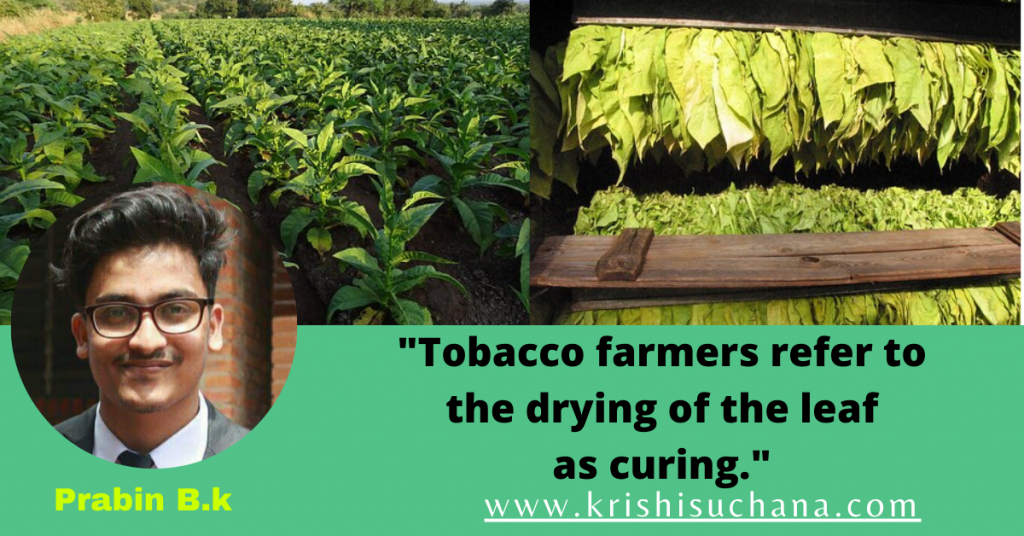Tobacco Leaf Harvesting, Curing and Fermenting

Harvesting Tobacco Leaves
Tobacco is harvested in one of two ways. The oldest known method in use is simply cutting off the stalk at the ground using a curved knife. The other way to harvest tobacco leaves originated in the nineteenth century. They started to harvest the tobacco plant by pulling individual leaves off the stalk as they ripened, tobacco leaves ripen from the ground upward, so tobacco plant may be pulled several different times before the tobacco plant is entirely harvested. This is also known as “Cropping” or “Priming”. These are terms used for pulling leaves off tobacco. To prevent breakage and bruising during the handling necessary in curing, it is desirable for the leaf to wilt without sun burning. Tobacco may be left in the field from a few hours to two days to wilt.
Curing of tobacco
The tobacco cultivating process takes about 20 weeks. After the tobacco plants are grown there are harvested and begin a 5-month process of drying, fermentation, de-ribbing and sorting, and then a second fermentation process before being stored. Curing tobacco has always been a process necessary to prepare the leaf for consumption because, in its raw, freshly picked state, the green tobacco leaf is too wet to ignite and be smoked. Tobacco curing is also known as color curing, because tobacco leaves are cured with the intention of changing their color and reducing their chlorophyll content. Curing and subsequent aging allow for the slow oxidation and degradation of carotenoids in the tobacco leaf.
Tobacco farmers refer to the drying of the leaf as curing. There are 4 main ways of curing tobacco. Curing methods vary with the type of tobacco grown.
Air-cured Tobacco leaves
Air-cured tobacco is carried out by hanging the tobacco in a well-ventilated barns, where the tobacco is allowed to dry over a period of four to eight weeks. Air-cured tobacco is generally low in sugar content, which gives the tobacco smoke a light, smooth, semi- sweet flavor. These tobacco leaves usually have a high nicotine content. Cigar and burley tobaccos are air cured.
Fire-cured tobacco leaves
This type of tobacco takes its name from the wood-fire curing process that is used to give the finished tobacco product a rich flavor profile which includes wood and smoke. Fire-cured tobacco is hung in large barns where fires of hardwoods are kept on continuous or intermittent low smoulder and takes between three days and ten weeks depending on the process and the tobacco. Fire curing produces a tobacco low in sugar and high in nicotine. Pipe tobacco, chewing tobacco, and snuff are fire cured.
Flue-cured Tobacco Leaves
Flue-cured tobacco started by stringing the tobacco into tobacco sticks, which were hung from tier-poles in curing barn’s “kilns”. All flue-cured barns have flues which run from external fed fire boxes, which heat-cures the tobacco without exposing it to smoke, slowly raising the temperature over the course of the curing process. The procedure will generally take about a week. Flue-cured tobacco generally produces cigarette tobacco. Cigarette tobacco usually has a high content of sugar, with medium to high levels of nicotine. Flue-cured tobacco requires an estimated one tree per 300 cigarettes.
Sun-cured Tobacco Leaves
Most to all sun-cured tobacco comes from countries that produce oriental leaves, such as Turkey, Greece, and the Republic of Macedonia. The sun-cured tobacco process works just how it sounds. The tobacco is placed in the sun uncovered, and is dried out naturally. Sun-cured tobacco is high in sugar and low in nicotine. In India sun curing is used to produce so-called “white” snuffs, which are fine, dry, and unusually potent.
Fermenting Tobacco Leaves
This is the process by which ammonia is released from the leaf to make it more sociable. It can be done by heaping the tobacco into large piles called pylons that raise the temperature and humidity, or by use of a kiln with a heater and humidifier. Under the raised temperature and humidity, enzymes in the leaf cause it to ferment. It is not necessary to spray a fermenting solution on the leaf as some suggest – the enzymes will do it naturally. Sometimes this is also referred to as curing.
There are two methods of fermenting, stacking and kiln fermenting.
Stacking
The stacking tobacco fermentation method is used by large growers. Stacks of tobacco weighing around 100lbs each are wrapped in burlap and allowed to “sweat”. The internal temperature is closely monitored. When it reaches 140 degrees, the stack is broken down to release tar, ammonia, and nicotine. The stack is torn down and rebuilt several times until the temp will no longer reach 110 degrees. The stems are they stripped and stacked in a cooler place (65 degrees to age for a time 6 weeks to 6 years).
Kiln fermenting
This is what the smaller grower must use if he or she wants to smoke the fruits of their harvest any time soon. The kiln is a small, insulated container with an artificial heat source that helps to simulate the fermentation. The leaves are placed in the kiln with the lid shut. Heat and humidity are carefully controlled (temp 100 to 130 degrees and 65 to 70% humidity), and the kiln is left on 24 hours a day. Kiln fermenting lasts about 4 to 6 weeks and the relative humidity must be carefully maintained during this time. A short aging period will follow of 4 to 6 weeks or longer until the leaves can either be rolled into cigars or cut for cigarette, pipe, or chewing tobacco.
Writer: Prabin B.k (College: Institute of agriculture and animal science, Address: Gauradaha, Jhapa )

